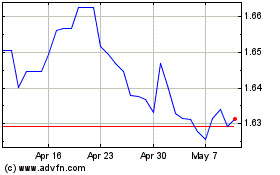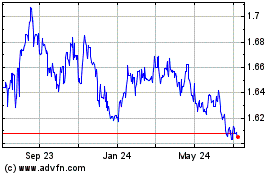Euro Dips After Eurozone Inflation Turns Negative Unexpectedly
September 30 2015 - 3:12AM
RTTF2
The euro drifted lower against its most major rivals in European
deals on Wednesday, as data showed that Eurozone consumer prices
fell for the first time in six months in September, largely due a
slump in oil prices.
Flash data from Eurostat showed that consumer prices fell
unexpectedly by 0.1 percent year-on-year in September, offsetting a
0.1 percent rise in August. Economists had forecast prices to
remain flat.
The European Central Bank's targets to bring inflation to
'below, but close to, 2 percent over the medium term'.
Excluding energy, food, alcohol and tobacco, core inflation
remained unchanged at 0.9 percent in September. The rate came in
line with expectations.
Eurozone unemployment rate remained unchanged in August,
separate data from the same agency showed.
The jobless rate held steady at double-digit 11 percent in
August. It was expected to remain at July's originally estimated
rate of 10.9 percent.
The European Central Bank President Mario Draghi had already
warned that the region could experience deflation in the coming
months, and the bank needs more time to assess whether the weakness
is a temporary or lasting phenomenon before further action.
The euro was trading lower against the greenback, pound and the
yen in the Asian session. Against the franc, the euro trended
higher.
In European deals, the euro fell to a 2-day low of 0.7379
against the pound, a 0.4 percent decline from its previous high of
0.7431. Continuation of the euro's downtrend may drive it down to a
support around the 0.725 mark. The euro-pound pair finished
Tuesday's deals at 0.7423.
Extending early slide, the common currency depreciated by 0.4
percent to 1.1202 against the greenback. The pair was quoted at
1.1247 when it closed Tuesday's deals. The euro may test support
around the 1.10 level.
The single currency pared gains to 1.0907 against the Swiss
franc, from a high of 1.0945 hit at 3:45 am ET. If the euro extends
slide, it may locate support near the 1.08 region. The euro-franc
finished Tuesday's trading at 1.0924.
The common currency reached as low as 1.5009 against the loonie
and 1.7549 against the kiwi, compared to Tuesday's closing values
of 1.5096 and 1.7720, respectively. If the euro extends slide, it
may find support around 1.48 against the loonie and 1.73 against
the kiwi.
The euro dropped to 1.5928 versus the aussie, a 2-day low, and
was down by 1.04 percent from yesterday's closing quote of 1.6096.
The euro is seen finding support around the 1.57 level.
Meanwhile, the 19-nation currency swung between gains and losses
against the Japanese yen, following a 5-day high of 135.12 hit at
8:30 pm ET. At Tuesday's close, the pair was trading at 134.67.
Looking ahead, U.S. private sector jobs data for September, U.S.
weekly crude oil inventories report for the week ended September 25
and U.S. Chicago PMI for September and Canada GDP data for July are
set to be announced in the New York session.
At 8:00 am ET, Federal Reserve Bank of New York President
William Dudley is expected to speak at the Securities Industry and
Financial Markets Association's Liquidity Forum, in New York.
Subsequently, Federal Reserve Chair Janet Yellen will deliver
opening remarks at the Federal Reserves' annual community banking
conference, in St. Louis at 3:00 pm ET.
Euro vs AUD (FX:EURAUD)
Forex Chart
From Mar 2024 to Apr 2024

Euro vs AUD (FX:EURAUD)
Forex Chart
From Apr 2023 to Apr 2024
